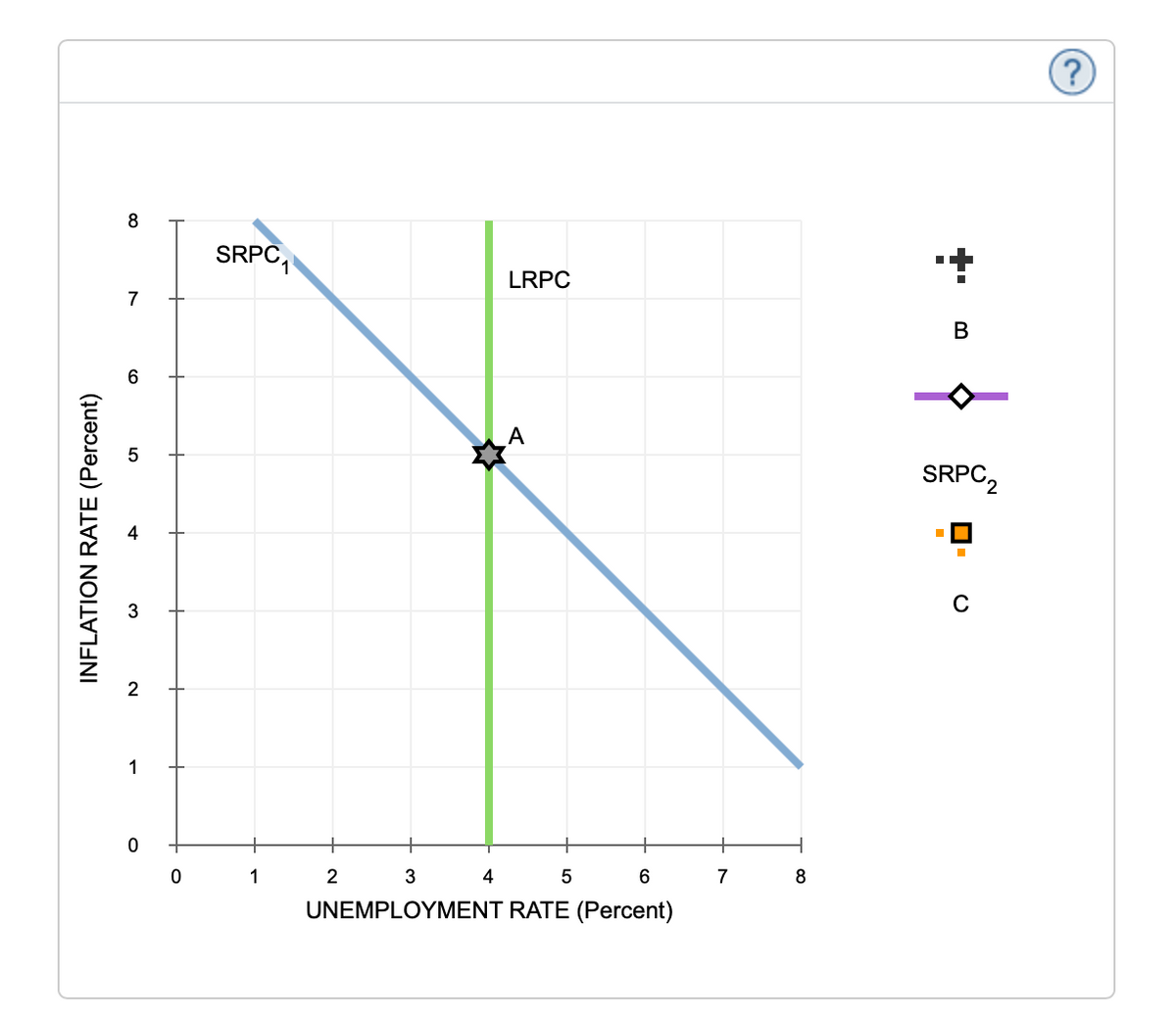The following graph plots the long-run Phillips curve (LRPC) and short-run Phillips curve (SRPC1SRPC1) for an economy currently experiencing long-run equilibrium at point A (grey star symbol). Which of the following is true along SRPC1SRPC1? -The actual unemployment rate is 6%. -The expected inflation rate is 5%. -The actual inflation rate is 5%. -The natural rate of unemployment is 3%. Suppose that the central bank for this economy suddenly and unexpectedly decreases the money supply in an effort
The following graph plots the long-run Phillips curve (LRPC) and short-run Phillips curve (SRPC1SRPC1) for an economy currently experiencing long-run equilibrium at point A (grey star symbol). Which of the following is true along SRPC1SRPC1? -The actual unemployment rate is 6%. -The expected inflation rate is 5%. -The actual inflation rate is 5%. -The natural rate of unemployment is 3%. Suppose that the central bank for this economy suddenly and unexpectedly decreases the money supply in an effort
Chapter1: Making Economics Decisions
Section: Chapter Questions
Problem 1QTC
Related questions
Question
The following graph plots the long-run Phillips curve (LRPC) and short-run Phillips curve (SRPC1SRPC1) for an economy currently experiencing long-run equilibrium at point A (grey star symbol).
Which of the following is true along SRPC1SRPC1?
-The actual unemployment rate is 6%.
-The expected inflation rate is 5%.
-The actual inflation rate is 5%.
-The natural rate of unemployment is 3%.
Suppose that the central bank for this economy suddenly and unexpectedly decreases the money supply in an effort to reduce inflation. As a result of this unanticipated policy action, actual inflation falls to 3%.
On the previous graph, use the black point (plus symbol labeled "B") to illustrate the short-run effects of this policy.
Suppose that now, after a period of 3% inflation, households and firms begin to expect that the inflation rate will persist at the level of 3%.
On the previous graph, use the purple line (diamond symbol) to draw SRPC2SRPC2, the short-run Phillips curve that is consistent with these expectations, assuming that it is parallel to SRPC1SRPC1.
Finally, using the orange point (square symbol labeled "C"), indicate on the previous graph the new, long-run equilibrium for this economy.
The inflation rate at point C is (higher than/the same as/lower than) the inflation rate at point A, and the unemployment rate at point C is (higher than/the same as/lower than) the unemployment rate at point A.
Was the central bank able to achieve its goal of lowering inflation?
-No, because the central bank cannot affect the inflation rate through monetary policy.
Now, suppose that the public fully anticipates the central bank's decision to decrease the money supply. Assume the public also believes that the monetary authority is firmly committed to carrying out this policy. According to rational expectations theory, when the economy is in long-run equilibrium, a fully anticipated decrease in the money supply will cause the economy to move on the previous Phillips curve graph. In this case, rational expectations theory predicts that the fully anticipated decrease
-Yes, but only in the short run; in the long run, inflation returned to its natural rate.
-Yes, the central bank’s policy successfully reduced inflation in both the short run and the long run.-

Transcribed Image Text:INFLATION RATE (Percent)
8
7
+
3
2
1
0
0
SRPC₁
1
2
4
LRPC
3
5
6
UNEMPLOYMENT RATE (Percent)
A
7
8
+
B
SRPC₂
·
C
?
Expert Solution
This question has been solved!
Explore an expertly crafted, step-by-step solution for a thorough understanding of key concepts.
This is a popular solution!
Trending now
This is a popular solution!
Step by step
Solved in 3 steps with 1 images

Knowledge Booster
Learn more about
Need a deep-dive on the concept behind this application? Look no further. Learn more about this topic, economics and related others by exploring similar questions and additional content below.Recommended textbooks for you


Principles of Economics (12th Edition)
Economics
ISBN:
9780134078779
Author:
Karl E. Case, Ray C. Fair, Sharon E. Oster
Publisher:
PEARSON

Engineering Economy (17th Edition)
Economics
ISBN:
9780134870069
Author:
William G. Sullivan, Elin M. Wicks, C. Patrick Koelling
Publisher:
PEARSON


Principles of Economics (12th Edition)
Economics
ISBN:
9780134078779
Author:
Karl E. Case, Ray C. Fair, Sharon E. Oster
Publisher:
PEARSON

Engineering Economy (17th Edition)
Economics
ISBN:
9780134870069
Author:
William G. Sullivan, Elin M. Wicks, C. Patrick Koelling
Publisher:
PEARSON

Principles of Economics (MindTap Course List)
Economics
ISBN:
9781305585126
Author:
N. Gregory Mankiw
Publisher:
Cengage Learning

Managerial Economics: A Problem Solving Approach
Economics
ISBN:
9781337106665
Author:
Luke M. Froeb, Brian T. McCann, Michael R. Ward, Mike Shor
Publisher:
Cengage Learning

Managerial Economics & Business Strategy (Mcgraw-…
Economics
ISBN:
9781259290619
Author:
Michael Baye, Jeff Prince
Publisher:
McGraw-Hill Education